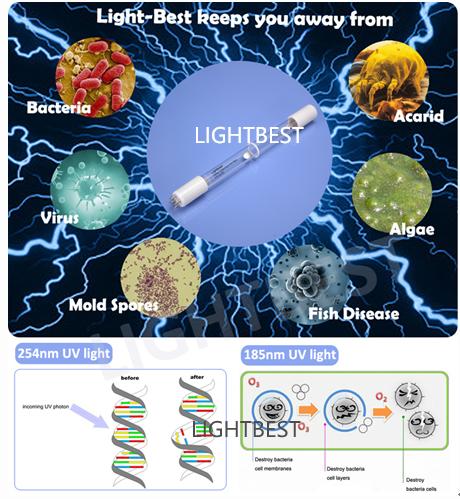The working principle of UV germicidal lamps is primarily based on the destructive effects of UV light on microorganisms such as bacteria, viruses, and fungi. By emitting specific wavelengths of ultraviolet light, these lamps can kill or inhibit the growth and reproduction of microbes. The detailed explanation is as follows:
Core Principle – Disruption of Microbial DNA/RNA by UV Light
The genetic material of microorganisms is either DNA (deoxyribonucleic acid) or RNA (ribonucleic acid), which carries all the genetic information necessary for their growth, reproduction, and metabolism. UV germicidal lamps primarily use UVC light (wavelength range 200–280 nanometers) to damage this genetic material, thereby achieving disinfection.
Specific Mechanism of Action
l Formation of Pyrimidine Dimers:
When microorganisms are exposed to UVC light, the UV radiation is absorbed by the nucleic acids (DNA or RNA) within their cells. The pyrimidine bases in the nucleic acids—mainly thymine—absorb the energy, causing adjacent pyrimidine bases to form covalent bonds, creating what are known as pyrimidine dimers. For example, in DNA, neighboring thymine bases may form thymine dimers.
l Inhibition of DNA Replication and Transcription:
The formation of pyrimidine dimers distorts the DNA’s double-helix structure. This distortion interferes with the normal process of DNA replication, as DNA polymerase cannot bypass these dimers effectively, preventing the creation of complete daughter DNA strands. It also disrupts the transcription process, hindering the production of essential proteins and enzymes.
l Microbial Death or Inactivation:
As DNA replication and RNA transcription are blocked, the microorganism can no longer grow, reproduce, or carry out metabolic activities. This leads to its death or loss of viability, effectively achieving disinfection.

Factors Affecting the Germicidal Effect of UV Light
l UV Wavelength:
Not all wavelengths of ultraviolet light have the same germicidal effectiveness. The UVC range has the strongest germicidal ability, with 265 nanometers being considered the most effective wavelength due to the peak absorption by microbial nucleic acids. Currently, the most commonly used commercial wavelength is 253.7 nm, which is very close to this peak.
l Irradiation Dose:
The irradiation dose refers to the product of UV intensity and exposure time. Generally, the higher the dose, the better the germicidal effect. However, beyond a certain point, increasing the dose yields diminishing returns and may potentially cause negative effects on surrounding materials.
l Type of Microorganism:
Different microorganisms have varying sensitivity to UV light. For example, bacterial spores are more resistant and require higher UV doses to be effectively inactivated. In contrast, viruses and non-spore-forming bacteria are more sensitive and can be killed with lower doses.
l Environmental Factors:
Environmental conditions such as temperature, humidity, and the presence of airborne particles also impact UV disinfection. High humidity can reduce effectiveness, as water molecules may absorb some UV energy. Suspended particles in the air can scatter UV rays, decreasing the amount of UV light that reaches the microorganisms.
Post time:2025-05-21 15:28:54

